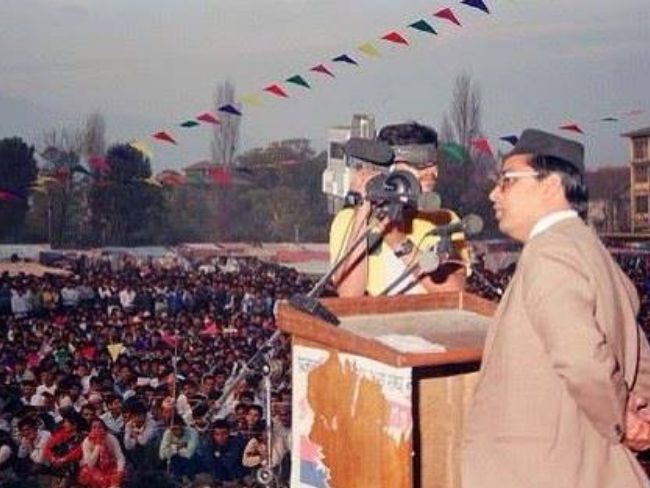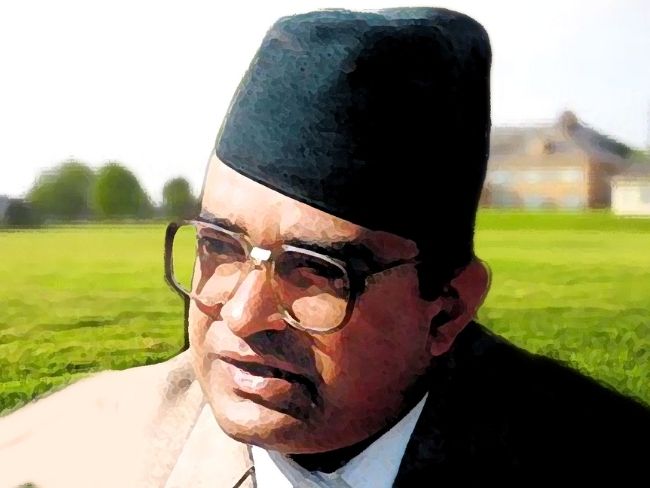Madan Kumar Bhandari, also known as Madan Bhandari, was a famous leader of Nepal and a key figure in the Communist Party of Nepal (UML). One of his biggest ideas was People’s Multiparty Democracy, which means people can choose their leaders in a fair way, even if they have different beliefs. This idea helped Nepal become a more democratic country after the year 1990. Bhandari’s work made a lasting impact on Nepali politics.
Quick Facts:
- Full Name: Madan Kumar Bhandari
- Born: June 27, 1951 (Asar 14, 2009 BS), Dhungesangu, Taplejung
- Died: May 16, 1993 (Jestha 3, 2050 BS), Dasdhunga, Chitwan
- Party: Communist Party of Nepal (Unified Marxist–Leninist) (CPN–UML)
- Position: General Secretary, CPN (ML) and later CPN (UML)
- Spouse: Bidya Devi Bhandari
- Children: Usha Kiran Bhandari, Nisha Kusum Bhandari
- Major Achievements: Led UML to 69 seats in 1991 election; defeated incumbent PM Krishna Prasad Bhattarai
- Memorials: Bust at Dasdhunga; jeep in Urlabari Museum; highway named in his honor
- Awards: Nepal Ratna Man Padavi, 2016 (posthumous)
Early Life and Education
Madan Kumar Bhandari was born on June 27, 1951, in a small village called Dhungesangu in Taplejung, eastern Nepal. He came from a simple Brahmin family. His father’s name was Devraj Bhandari (some say Dev Prasad Bhandari), and his mother’s name was Chandra Kumari.
As a child, Madan studied in a Sanskrit school in his village. Later, he went to India to study more. He lived in Varanasi, where he went to Banaras Hindu University. There, he studied literature and language and earned a master’s degree. While he was studying, he became very interested in Marxist ideas and started working in student politics.
Political Foundation
Madan Bhandari started his political work in 1972 by joining a group called the Democratic Cultural Front, started by a leader named Pushpa Lal Shrestha. He wanted to bring change, but he didn’t agree with the old communist leaders who were not doing much.
So, he joined hands with other young revolutionaries and helped form a group called Mukti Morcha (Liberation Front) in the mid-1970s. This group later became part of a bigger party called the Communist Party of Nepal (Marxist-Leninist).
Because he was smart and active, Madan Bhandari quickly became one of the top leaders. By the late 1970s and early 1980s, he was chosen to be in the Central Committee and Politburo, which are important decision-making groups in the party.
In 1988, he was made General Secretary of the party, which means he became its main leader.
Rise to Prominence and Push for Democracy
In 1990, there was a big movement in Nepal called the People’s Movement (Jana Andolan). It was a peaceful protest to bring democracy to the country. During this time, Madan Bhandari worked with other political parties, like the Nepali Congress, to support the movement.
After the movement succeeded, two communist parties came together to form a new party in 1991 called the Communist Party of Nepal (Unified Marxist-Leninist), or CPN-UML. At that point, Madan Bhandari became the party’s general secretary, and Manmohan Adhikari became its chairman.
Under Madan’s leadership, the party performed very well in Nepal’s first democratic election in decades. Surprisingly, the party won 69 seats out of 205, which shocked many people. Even more impressively, Madan Bhandari won against former Prime Minister Krishna Prasad Bhattarai in Kathmandu.

People’s Multiparty Democracy (PMPD)
One of Madan Bhandari’s biggest ideas was People’s Multiparty Democracy (PMPD). This idea said that socialism (fairness for all people) could be reached through elections, freedom, and democracy, not violence.
He shared this idea in the early 1990s, and the party officially accepted it in 1993. Many people around the world said this idea was new and smart. Some even said that “Karl Marx lives in Nepal” because of Madan’s creative thinking.
This idea helped shape Nepal’s political future. It became a base for important events like the 2006 movement and the writing of Nepal’s new constitution in 2015.
Personal Life
Madan Bhandari married Bidya Devi Bhandari in 1982. At that time, she was also a young political leader. They had two daughters, named Usha Kiran and Nisha Kusum.
After Madan’s sudden death, Bidya Devi Bhandari continued her political work. She later became Nepal’s first female president, serving from 2015 to 2023.
Death and Unresolved Mystery
On May 16, 1993, when Madan Bhandari was just 41 years old, he died in a jeep accident in a place called Dasdhunga, in the Chitwan district. Another important leader, Jibaraj Ashrit, also died in the crash. Only the driver, Amar Lama, survived.
But later, many people began to suspect that someone had planned the crash. In 2003, unknown individuals kidnapped and killed Amar Lama in Kathmandu, which increased suspicions of murder.
After his death, thousands of people came to the Dasharath Stadium to say goodbye. A statue (bust) of him was built at the crash site, and the jeep from the crash is now shown in a museum in Urlabari, Morang. The government also named a big road after him, “Madan Bhandari Highway.”
In 2016, the Government of Nepal gave him the Nepal Ratna Man Padavi, the highest national honor, for his service to the country.
Legacy
Madan Bhandari is remembered as a great speaker, a wise leader, and someone who changed Nepali politics. He helped bring democracy into the communist movement and believed that freedom, voting, and fairness could all go together.
His ideas still inspire political leaders today. People respect him for making his party strong and for helping Nepal move toward a better, more democratic future.
Conclusion
Madan Kumar Bhandari is still remembered today because of his big ideas, especially People’s Multiparty Democracy. He wanted to create a peaceful and fair political system where everyone’s voice mattered. Even though he died young, his thoughts and beliefs still guide Nepal’s leaders, laws, and politics. He was a leader who truly cared about ordinary people, and his legacy lives on.
You May Also Like:





Comments are closed